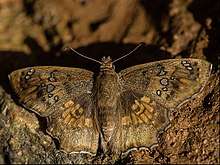Caprona ransonnetii
Caprona ransonnetii, commonly known as the golden angle,[1] is a butterfly belonging to the family Hesperiidae. It was first described by Baron Cajetan von Felder in 1868.[2][3][4][1][5][6]
| Golden angle | |
|---|---|
 | |
| Wet-season form | |
| Scientific classification | |
| Kingdom: | |
| Phylum: | |
| Class: | |
| Order: | |
| Family: | |
| Genus: | |
| Species: | C. ransonnetii |
| Binomial name | |
| Caprona ransonnetii (C. Felder, 1868) | |
| Synonyms | |
| |
Subspecies
The subspecies of Caprona ransonnetii include:
Description
.jpg)
In 1891, Edward Yerbury Watson gave this detailed description:
Upperside fuliginous ochreous-brown. Male; forewing with three small semi-transparent white spots before the apex (and sometimes one or two very minute spots obliquely below them), two spots within end of the cell, a slender spot between the upper and middle median veins, a larger spot between the latter vein and submedian, and followed below it by two small obliquely disposed spots; a marginal double row of pale indistinct small lunules; hindwing with a broad medial discal macular pale ochreous band traversed by brown veins and a spot within end of the cell, the outer discal area suffused with grey-brown. Cilia alternated with white. Female; forewing with the spots and marginal lunules, and the macular band on hindwing more prominent, the latter also more distinctly bordered with grey. Underside: forewing paler brown; the basal area greyish-white, the spots with clouded black outer borders; hindwing greyish-white, the outer margin only being brown, traversed by a curved discal series of small blackish spots.[8]
The dry-season form which has been named A. taylorii by de Niceville differs in being ochreous not dark brown above, and in having the disc of the hindwing unmarked with a group of ochreous spots and streaks. A similar variation has been noted by Mr. de Niceville in C. tissa, a not very distantly allied species, and in both cases it is the dry-season form which is the paler.[8]
— E.Y. Watson
Gallery
 Closed wing position
Closed wing position Closed wing position
Closed wing position
References
- Varshney, R.; Smetacek, P. A Synoptic Catalogue of the Butterflies of India (2015 ed.). New Delhi: Butterfly Research Centre, Bhimtal and Indinov Publishing. p. 33.
- Savela, Markku. "Caprona ransonnetii (Felder, 1868)". Lepidoptera and Some Other Life Forms. Retrieved June 30, 2018.
- Felder, Baron Cajetan von (1868). "Diagnose neuer von E. Baron v. Ransonnet in Vorder-Indien gesammelter Lepidopteren". Zoologisch-Botanische Gesellschaft in Wien. 18 (1–2): 284.
- Moore, Frederic (1880). The Lepidoptera of Ceylon. London: L. Reeve & co. p. 182.
- W. H., Evans (1949). A Catalogue of the Hesperiidae from Europe, Asia, and Australia in the British Museum. London: British Museum (Natural History). Department of Entomology. p. 160.
-

- "Caprona ransonnettii Felder, 1868 – Golden Angle". Retrieved 26 August 2017.
- E. Y., Watson (1891). Hesperiidae Indicae : being a reprint of descriptions of the Hesperiidae of India, Burma, and Ceylon. Madras: Vest and Company. p. 99.
External links
| Wikimedia Commons has media related to Caprona ransonnetii. |
| Wikispecies has information related to Caprona ransonnetii |